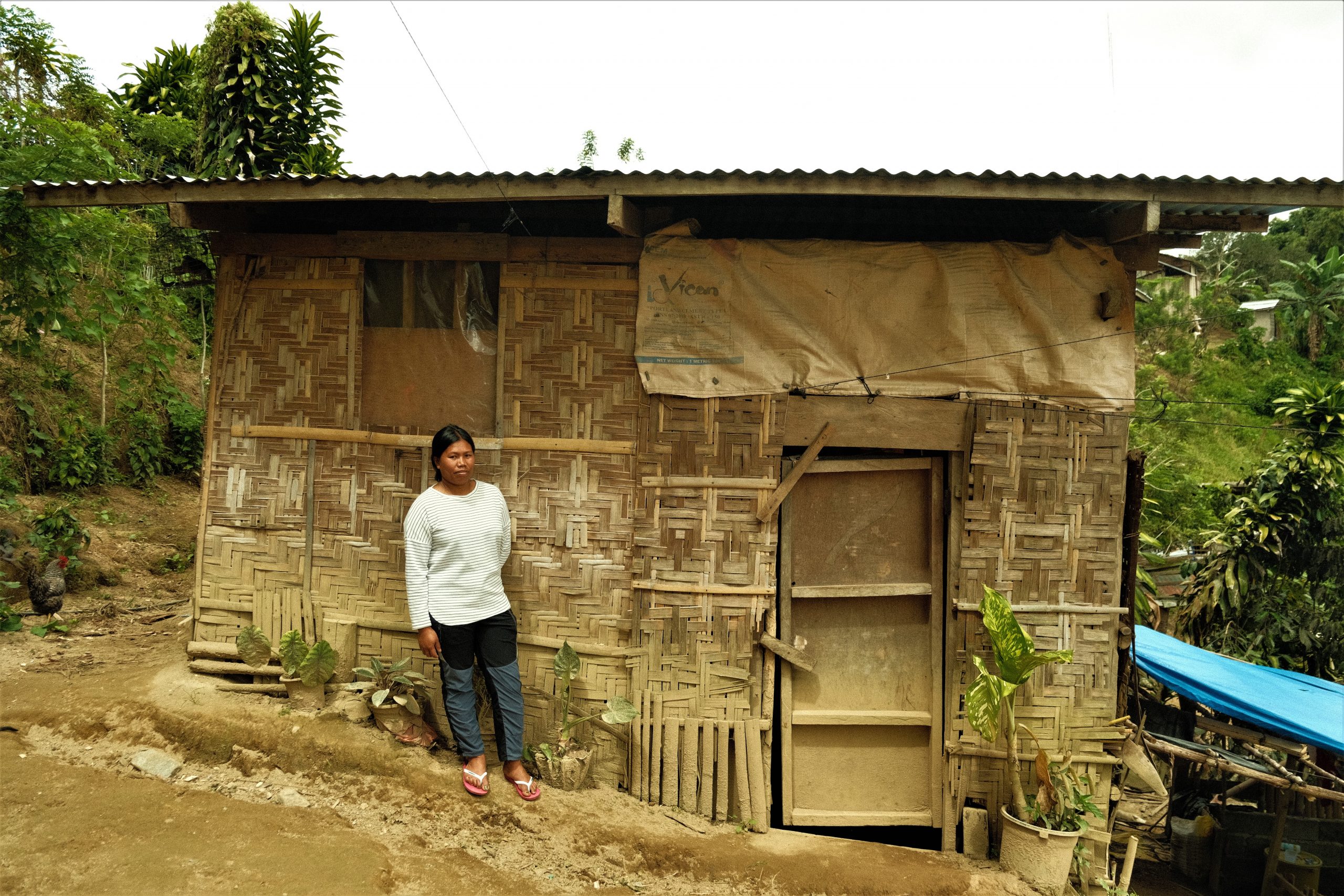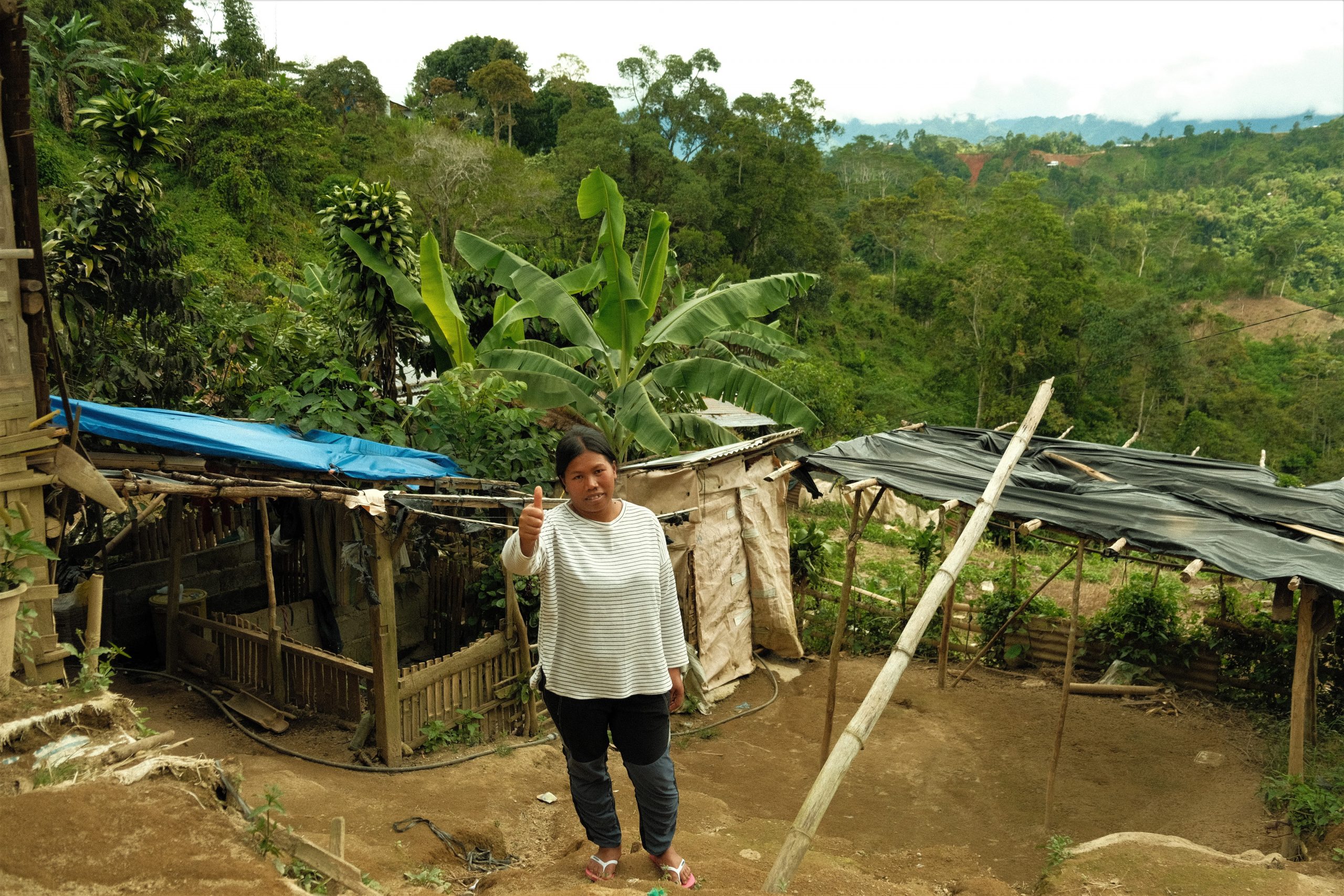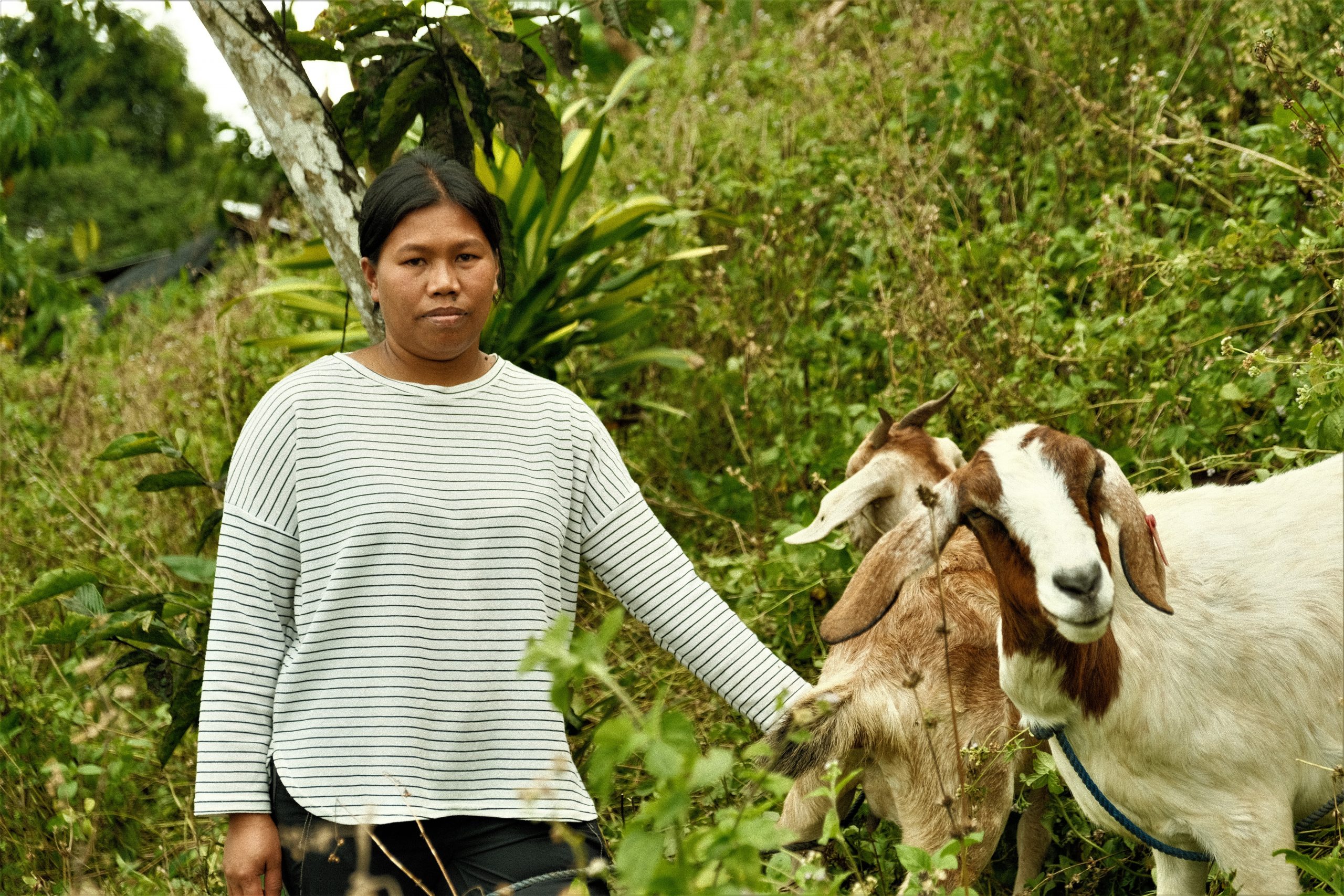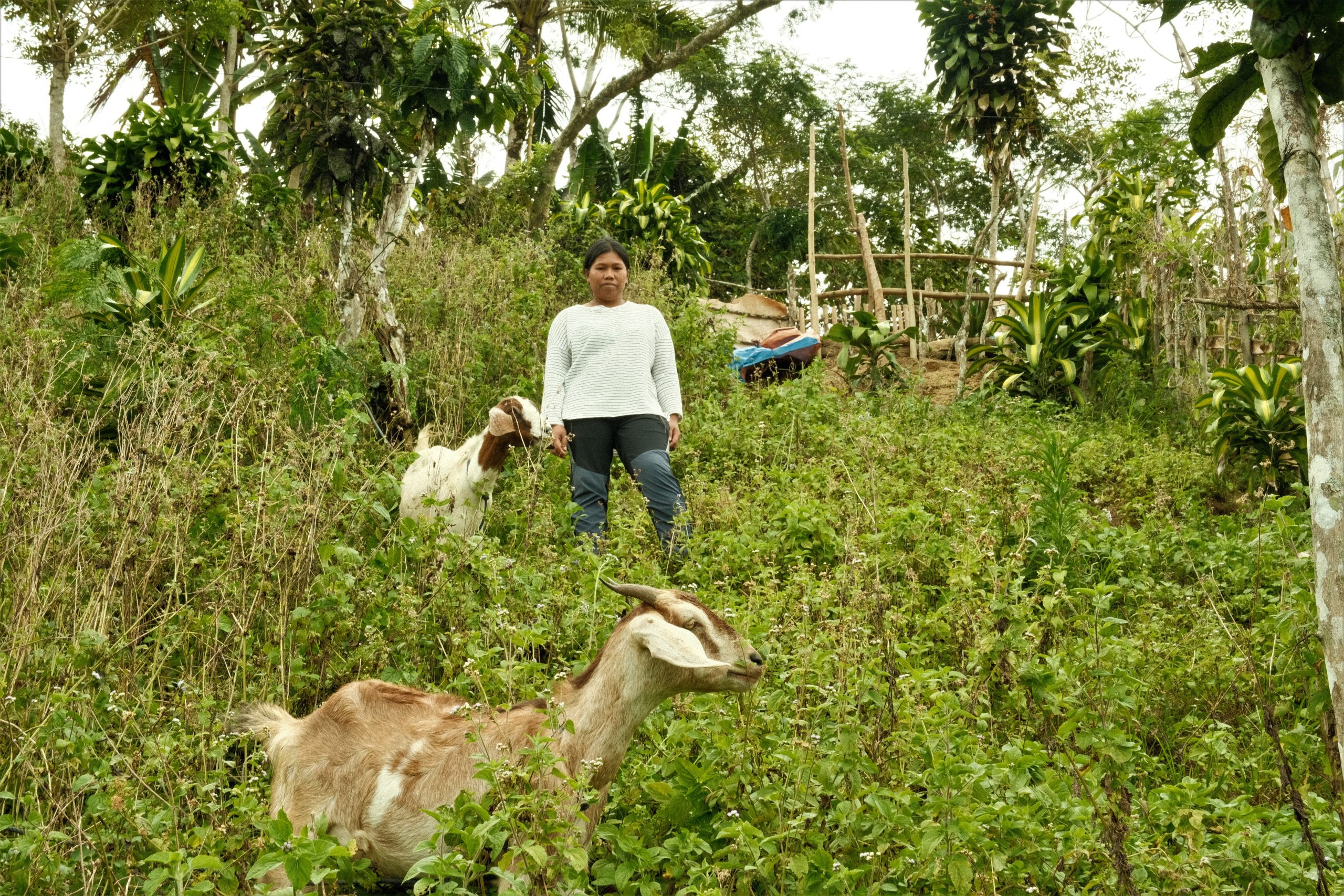“Kaning lote ug payag, tungod sa kanding jud ni” (The lot and this house, they’re from the goats).
In Barangay Mahayahay, Maragusan, Narcisa Navales starts and ends her day herding goats. Mahayahay, a vegetable-producing barangay similar to the majority of Maragusan, is one of the farthest in the municipality at an elevation of more than 1,100 meters above sea level. The weather is temperate all year round, with downpours always expected on afternoons.
Together with her husband, Winnie, they till a two-hectare rolling land with vegetables, such as chayote, tomatoes, and Kentucky beans. The mother of three also moonlights as a utility worker for the barangay.
For two consecutive years, Ms. Navales was an individual beneficiary of the SAAD program’s Upgraded Goat Production. She got two does in 2019 and a buck and a doe in 2020. The barangay’s topography provided plenty of grazing area for the livestock, which she took advantage of and slowly increased the number in her herd. Soon after, she started selling does and bucks she deemed dispensable.
“Ibaligya nako ang mga inahan nga di kabalo mu-amoma sa iyang mga anak…ang nagapalit diri mga pulis. Muari man jud sila diri, usahay gusto ug buntis, ibaligya nako ug mas mahal. Basta laki nga dagkoon pud” (I sell does that don’t know how to take care of their kids…the police [assigned] here are some of my buyers. They would seek me, sometimes they really want those does that are already pregnant, so I would sell at a higher price. I also sell robust bucks at a price), Ms. Navales related.
In Davao de Oro, liveweight selling prices of goats go at a minimum of Php 3,500 for a 15 kilograms (kg) doe.
“Katong nikabat ug unom akong mga inahan, tag-duha tulo akoang dal-on ibaligya” (When I reached 6 does, I would sell two or three), she said. “Nakatabang jud sa amoa. Nangandoy mi diri nga makapalit unta mi ug lote” (It [ SAAD’s goat production project] helped. We started dreaming that we maybe could buy a lot).
That dream turned into a goal Ms. Navales worked to achieve. In hilly and mountainous areas like Mahayahay, farming lots are far-flung, usually, an hour or so hike. Getting a lot nearby the barangay’s center is practical for her work and her children’s schooling. Mahayahay is the topmost barangay in one of many mountainous parts of Maragusan and accessibility to basic living resources means a significantly improved quality of life when compared to living in a farm lot away from the community. It also decreases vulnerability to a potential brush with communist forces.
From 2020 up until writing, she has earned Php 95,500 from selling goats alone. She sold 18 goats in total, averaging a little more than Php 5,300 each. Two does from the lot fetched an impressive price of Php 10,000 each.
“Katong daghan na amoang kanding gipangbaligya, gi-downan na namo dayon ni nga lote” (When the number in the herd increased, we started regularly selling, and [from that] we put a downpayment to this lot), she declared. “Gi-anamanam namo. Kaning lote ug payag, kanding jud ni” (We worked on it steadily. The lot and this house, they’re from the goats).
The lot she and her husband bought was significantly closer to the barangay’s center than the one they till, only a few meters away from the barangay hall. It has an overlooking view of the greater Maragusan below. The lot set them back Php 30,000.
“Duha ni ka-lotehan, dies por dies. Kwaan siya, 200 square meters guro” (The lot is divided into two 10 by 10, more or less 200 square meters in all).
On the lot, Ms. Navales started building a house, with the same income from selling goats.
Additionally, the money overarched to a downpayment for her son’s motorcycle. The eldest, at 14, goes to school in neighboring barangay Parasanon. Believing in the importance of imparting the value of hard work, she shared that a kid is assigned to each of her children. The motorcycle’s downpayment, Php 6,500, was all of her son’s income from the goat she entrusted him.
“Pagpanganak sa mga kanding, ginahatagan nako. Katong first nga gianak sa SAAD, na-down sa motor ang halin” (When the does bear kids, I give one to each of them. The first kids from [the goats] SAAD gave, the money was used as downpayment for the motorcycle), she said. Her eldest uses the motorcycle as primary transport vehicle for schooling.
“Kana imoha na, atimana na ug maayo. Tugway taga-buntag bago muadto ug eskwelahan” (That is yours [pertaining to the goat], take good care of it. You herd it in the morning before going to school).
SAAD’s 11 Upgraded Goats Production Project
Upgraded Goat Production has been a mainstay livelihood project for SAAD RPMSO 11 since 2018. Based on a needs assessment, the project was identified as an intervention for Geographically Isolated and Disadvantaged Areas (GIDA) and End Local Communist Armed Conflict (ELCAC) areas because of the small ruminant’s hardiness and liveweight selling potential. Upgraded goats are the offspring of a native breed and either an Anglo-Nubian or Boer pairing.
In 2019 and 2020, SAAD distributed upgraded goats in a 1:9 pairing ratio, at 8-10 months old, weighing at least 17kg to identified beneficiaries in Davao de Oro. The distributed goats were certified free of Caprine Arthritis Encephalitis (CAE) and Brucella by the Regional Animal Disease Diagnostic Laboratory’s (RADDL) veterinarians before delivery. In case of death within seven days after distribution, the beneficiaries were also entitled to a replacement. The project benefitted 350 individual beneficiaries in 2019, then 5 groups and 289 farmers in 2020 across Davao de Oro.
Upgraded goats are hardy and pose better monetary rewards for individual beneficiaries within a year of distribution. Technically, a doe can be impregnated twice a year with one to two offspring each pregnancy.
“Kani, makapadungag jud sa ilahang panginabuhian. Gihatag nato sa ilaha tanan, naa tay training beforehand ug naa pud tay technical briefing sa distribution. Kita sa region nanghinaot nga ilaha jud ning mapa-lungtad” (This will add to their livelihood. We’ve provided them as much as we can, we had [goat] training beforehand and we also had technical briefing upon distribution. We hope that they can sustain it), Naomi Lamata, SAAD Region 11 Focal Person, said.
In 2021, SAAD 11 transitioned to giving farm implements from individual farmers to group beneficiaries. In Mahayahay, the group beneficiary identified was Malamboon Farmers Consumers Cooperative which received abaca plantlets with a stripping machine from the program. Ms. Navales is a member of the FA, earning her access to the plantlets. Unfortunately, the ones she planted were eroded by a landslide. She’s working to get monetary compensation for it through the Philippine Crop Insurance Corporation.
Implementation
Asked about her implementation, Ms. Navales related, “Bisan asa na nga area namo ginatugway, basta lang musugot ang tag-iya. Kanang mga mani-manihan” (We herd them everywhere provided the owner of the lot permits it, especially those with peanut grass).
“Tahop ug feeds. Ginapainom pud jud namo sila ug kanang asin, tubig matag hapon. Ginapurga taga-bulan” (Bran (chaff) and feeds. We let them drink water with salt every afternoon as well. Then, monthly purging), she added.
Just a few meters away from the house she built, there’s a makeshift pen for her goats to rest in the evenings. Currently, Ms. Navales has three goats remaining, two of which, named Pine and Melda, are pregnant.
“Proud jud kaayo ko muingon nga tungod jud sa kanding, ug SAAD naa mi karon diri” (I’m so proud to say that because of the goats and SAAD, we are where we are now), she concluded.
Owning a house and lot is a universal experience most aspire to achieve. For farmers in GIDA and ELCAC area, a house and lot, however small and meager, may very well be the representation of a life’s work to bring their family to safety. At its core, the SAAD Program works to provide additional income streams to these marginalized farmers. Ms. Navales, for all intents and purposes, is well on her way.
Writer: James Brian R. Flaga, DA-SAAD Region 11 Information Officer
Source: DA-SAAD Davao de Oro





Comments (0)